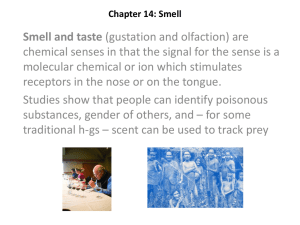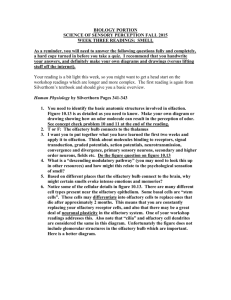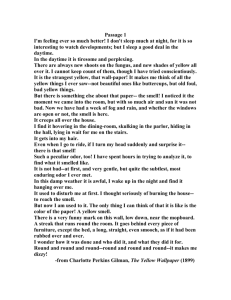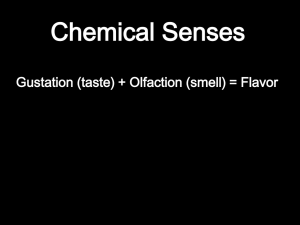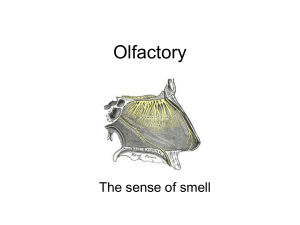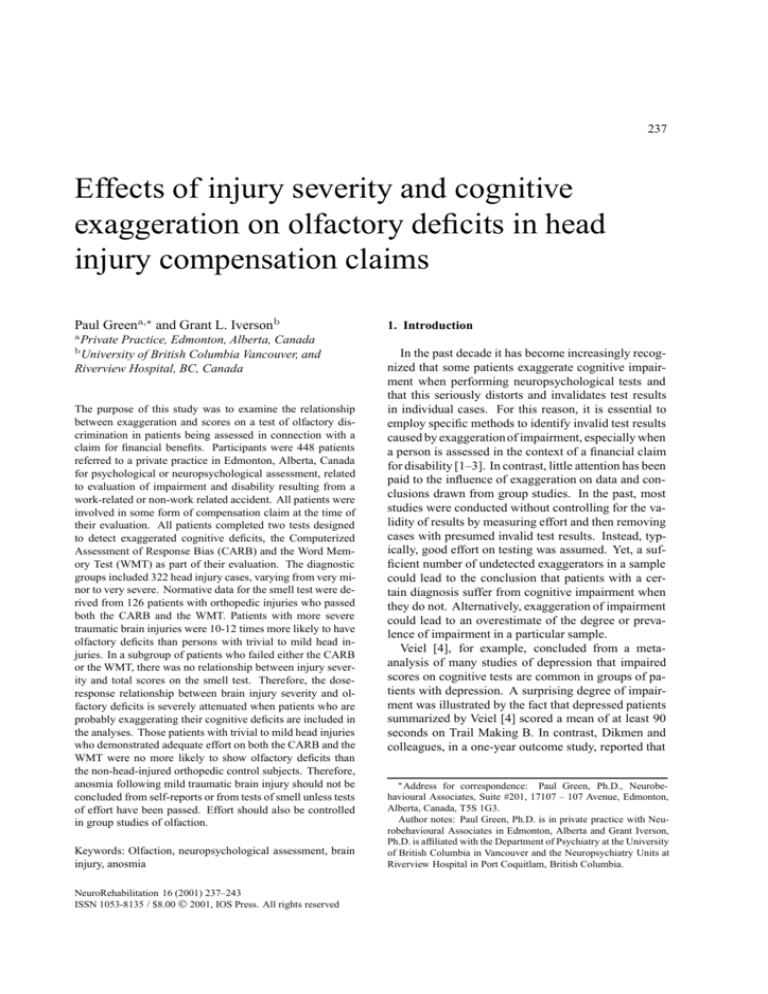
237
Effects of injury severity and cognitive
exaggeration on olfactory deficits in head
injury compensation claims
Paul Greena,∗ and Grant L. Iversonb
a
Private Practice, Edmonton, Alberta, Canada
b
University of British Columbia Vancouver, and
Riverview Hospital, BC, Canada
The purpose of this study was to examine the relationship
between exaggeration and scores on a test of olfactory discrimination in patients being assessed in connection with a
claim for financial benefits. Participants were 448 patients
referred to a private practice in Edmonton, Alberta, Canada
for psychological or neuropsychological assessment, related
to evaluation of impairment and disability resulting from a
work-related or non-work related accident. All patients were
involved in some form of compensation claim at the time of
their evaluation. All patients completed two tests designed
to detect exaggerated cognitive deficits, the Computerized
Assessment of Response Bias (CARB) and the Word Memory Test (WMT) as part of their evaluation. The diagnostic
groups included 322 head injury cases, varying from very minor to very severe. Normative data for the smell test were derived from 126 patients with orthopedic injuries who passed
both the CARB and the WMT. Patients with more severe
traumatic brain injuries were 10-12 times more likely to have
olfactory deficits than persons with trivial to mild head injuries. In a subgroup of patients who failed either the CARB
or the WMT, there was no relationship between injury severity and total scores on the smell test. Therefore, the doseresponse relationship between brain injury severity and olfactory deficits is severely attenuated when patients who are
probably exaggerating their cognitive deficits are included in
the analyses. Those patients with trivial to mild head injuries
who demonstrated adequate effort on both the CARB and the
WMT were no more likely to show olfactory deficits than
the non-head-injured orthopedic control subjects. Therefore,
anosmia following mild traumatic brain injury should not be
concluded from self-reports or from tests of smell unless tests
of effort have been passed. Effort should also be controlled
in group studies of olfaction.
Keywords: Olfaction, neuropsychological assessment, brain
injury, anosmia
NeuroRehabilitation 16 (2001) 237–243
ISSN 1053-8135 / $8.00 2001, IOS Press. All rights reserved
1. Introduction
In the past decade it has become increasingly recognized that some patients exaggerate cognitive impairment when performing neuropsychological tests and
that this seriously distorts and invalidates test results
in individual cases. For this reason, it is essential to
employ specific methods to identify invalid test results
caused by exaggeration of impairment, especially when
a person is assessed in the context of a financial claim
for disability [1–3]. In contrast, little attention has been
paid to the influence of exaggeration on data and conclusions drawn from group studies. In the past, most
studies were conducted without controlling for the validity of results by measuring effort and then removing
cases with presumed invalid test results. Instead, typically, good effort on testing was assumed. Yet, a sufficient number of undetected exaggerators in a sample
could lead to the conclusion that patients with a certain diagnosis suffer from cognitive impairment when
they do not. Alternatively, exaggeration of impairment
could lead to an overestimate of the degree or prevalence of impairment in a particular sample.
Veiel [4], for example, concluded from a metaanalysis of many studies of depression that impaired
scores on cognitive tests are common in groups of patients with depression. A surprising degree of impairment was illustrated by the fact that depressed patients
summarized by Veiel [4] scored a mean of at least 90
seconds on Trail Making B. In contrast, Dikmen and
colleagues, in a one-year outcome study, reported that
∗ Address for correspondence: Paul Green, Ph.D., Neurobehavioural Associates, Suite #201, 17107 – 107 Avenue, Edmonton,
Alberta, Canada, T5S 1G3.
Author notes: Paul Green, Ph.D. is in private practice with Neurobehavioural Associates in Edmonton, Alberta and Grant Iverson,
Ph.D. is affiliated with the Department of Psychiatry at the University
of British Columbia in Vancouver and the Neuropsychiatry Units at
Riverview Hospital in Port Coquitlam, British Columbia.
238
P. Green and G.L. Iverson / Effects of injury severity and cognitive exaggeration
the mean Trail Making B score was 71 seconds for
patients with traumatic brain injuries who had loss of
consciousness of up to an hour, and it was 101 seconds
for patients with very severe brain injuries who were
unable to respond to commands for up to two weeks after head injury [5]. Slower Trail Making B scores in patients with depression compared to patients with brain
injuries begs the question of whether the depressed patients actually had greater cognitive impairment than
people with severe brain injuries? It should be noted
that such an assumption was not made by Veiel [4], who
simply reported the test findings without interpreting
their underlying causes. It is possible that the impaired
test scores in depressed patients arose partly from exaggeration of impairment or lack of motivation to do well
on tests. One study controlled for effort by removing all
cases who failed symptom validity tests (SVTs) from
an initial sample of 658 outpatients, predominantly patients with head injuries, neurological diseases, major
depression, and orthopedic injuries. In the 452 remaining patients, who passed the SVTs, Rohling et al. [6]
concluded that there were no significant differences on
any neuropsychological tests between those with very
high levels of self-reported symptoms of depression
versus those with very few depressive symptoms.
Rohling and colleagues showed that, in a large neuropsychological test battery applied to 904 consecutive
patients claiming compensation for disability, a composite variable derived from two SVTs and a third effort
measure explained 53% of the variance in all 43 neuropsychological test scores combined [7]. In contrast,
years of education, which is known to be an important
determinant of test scores, explained only 11% of the
variance in the same data. Such findings raise the possibility of widespread but heretofore unidentified adverse effects of poor effort in group studies. This is
especially true for studies involving patients for whom
financial compensation is potentially available, such as
in cases involving chronic pain, chronic fatigue syndrome, psychiatric illnesses, or head injuries. This possibility is supported by a study in which significantly
more chronic fatigue syndrome cases failed an effort
test, compared to patients with multiple sclerosis [8].
The authors cautioned against assuming that abnormal
test findings necessarily imply cerebral impairment and
they urged the use of effort tests (SVTs) in future research.
It is well known that traumatic brain injuries can
cause anosmia or lesser forms of olfactory dysfunction.
In persons who sustain severe traumatic brain injuries,
the olfactory system can be compromised by several
mechanisms. Trauma to the face can cause a fracture of
the ethmoid bone, which is one mechanism for severing of olfactory fibres that pass through the cribriform
plate to the olfactory bulbs. The olfactory nerves run
within these bulbs on the surfaces of the orbital-medial
aspects of each frontal lobe, so damage to this region
(e.g., contusions or edema) can compromise olfaction.
Moreover, damage to areas underlying the ventromedial aspects of the temporal lobes, including the olfactory cortex, can compromise olfaction. Over the
years, olfactory deficits have been well-recognized in
the traumatic brain injury literature [9–12].
It is essential, however, to consider alternative explanations when a person with a history of traumatic
brain injury reports olfactory problems. Certainly, the
most common causes of bilateral anosmia or hyposmia
(diminished sense of smell) are the common cold or
trauma to the nose (Pourmand [13]). Moreover, because loss of sense of smell is a compensable loss that
can only be determined by self-report or by tests of odor
discrimination, anosmia is susceptible to exaggeration
or faking. Green and Iverson [14] reported that persons
involved in mild head injury litigation were much more
likely to perform poorly on a smell discrimination test
if they also demonstrated biased responding on a symptom validity test. The strong association between exaggeration during neuropsychological testing and poor
smell discrimination was not seen in persons with severe traumatic brain injuries who were also involved
in litigation. Thus, it is apparent that deliberate exaggeration should be considered when interpreting the
results of smell discrimination tests in persons involved
in head injury litigation.
Doty and colleagues reported poor smell test scores
in 87.3% of 268 people complaining of olfactory dysfunction secondary to head trauma [15]. In this study,
smell test performance did not appear to be related to
severity of brain injury. There was no reported difference in the incidence of olfactory deficits in people with mild head injury with no LOC and those with
more than 24 hours of LOC. There are two reasons why
the results of this study have limited generalizability.
First, the sample was unique in that patients complaining of olfactory problems were self-referred to a smell
and taste clinic. Second, Doty et al. [15] did not employ symptom validity tests to identify the possibility
of deliberate exaggeration, and they did not address or
control for compensation seeking.
The purpose of this study was to examine the relationship between exaggeration and scores on a test of
olfaction in patients being assessed in connection with
P. Green and G.L. Iverson / Effects of injury severity and cognitive exaggeration
a claim for financial benefits. It was hypothesized that
patients who showed exaggeration of impairment by
failing tests of effort (SVTs) would score lower on a
smell test than those who passed the effort tests. As in
previous studies [16,17], it was expected that failure on
symptom validity tests would be more frequent in cases
of mild head injury than in moderate to severe brain
injuries. It was also hypothesized that, after removing
cases showing negative response bias or exaggeration
of impairment, smell test scores would be related to
brain injury severity. Patients with more severe brain
injuries were expected to perform more poorly than patients with mild head injuries on a smell discrimination
test.
2. Method
2.1. Subjects
Participants were 448 patients referred to a private
practice in Edmonton, Alberta, Canada for psychological or neuropsychological assessment, related to evaluation of impairment and disability resulting from a
work-related or non-work related accident. All patients
were involved in some form of compensation claim at
the time of their evaluation. The diagnostic groups included 322 head injury cases, varying from very minor
to very severe. The average age of the patients was 38.7
years (SD = 12.1) and their average education was
11.8 years (SD = 2.7). The sample was 79% male and
21% female. In order to establish relevant norms for
comparison purposes, we also included a group of 126
people with recent orthopedic injuries not involving the
head. These orthopedic patients all passed two tests
designed to detect exaggerated cognitive deficits, the
Computerized Assessment of Response Bias and the
Word Memory Test (described in the next section). The
average age of the sample was 36.9 years (SD = 8.9)
and their average education was 11.0 years (SD = 2.3).
2.2. Assessment procedures
As part of a comprehensive neuropsychological assessment, all outpatients were given a test of odor discrimination and two separate SVTs designed to detect
exaggeration of cognitive impairment or inadequate effort. The Alberta Smell Test [14] involves ten trials in
each nostril, in which the person is required to identify
the odor presented. Subjects were required to close
their eyes, close one nostril at a time and sniff when
239
told to do so. Scented markers with authentic essences
of lemon, orange, licorice, cinnamon, mint, raspberry,
grape, and melon were presented half an inch below
one nostril at a time. Subjects were asked to identify the odors from a list of eight options printed on a
sheet of paper. The results were the number of correct
responses out of ten for each nostril. The non-toxic
scented water-color markers are widely available, very
inexpensive, and have been manufactured by Sanford
USA since 1972 under the trade name “Mr. Sketch”
scented markers for use by young children.
The SVTs or tests of effort employed were the Computerized Assessment of Response Bias [18–20] and
the Word Memory Test [16,17,21,22]. The CARB is a
computerized forced choice digit recognition test with
three blocks of 37 trials each. In the revised version
used in this series, the subject has to watch a five digit
number, (e.g., 58761) for two and a half seconds and
then select that number from two options shown on the
screen either 1.5, 2.5, or 3.5 seconds later. Patients with
severe brain injury have been found to be able to score
easily above the CARB cut-offs published in the test
manuals and test scores are uncorrelated with age and
intelligence [18–20]. Therefore, CARB is considered
to be a test of effort and not ability.
The Word Memory Test [21] is a computerized or
orally administered test with six subtests, some measuring effort applied to testing and others measuring
memory for words. In the computerized version, which
was used in this study, the subject is instructed to watch
and remember a list of twenty simple word pairs (e.g.,
dog/cat, man/woman, pig/bacon, fish/fin). The list is
presented twice on the screen and each word pair appears for six-seconds. After the second presentation of
the list, the person is shown word pairs containing only
one of the words from the original list (e.g., dog/rabbit)
and the person selects the word from the original list by
pressing the left or right shift key. A similar recognition test employing different foil words (e.g., dog/rat)
is administered after a 30-minute delay. The WMT effort measures are the percent correct scores from each
recognition trial and the level of consistency of responses between these two trials. These subtests are
thought to measure effort rather than ability because
patients with moderate to severe traumatic brain injury
have been found to score well above the published cutoffs and the test scores are unrelated to age and years
of education [20]. They are unaffected by level of posttraumatic amnesia, Glasgow Coma Scale scores, or the
presence or absence of impaired verbal memory or CT
abnormalities of the brain in samples of patients with
240
P. Green and G.L. Iverson / Effects of injury severity and cognitive exaggeration
head injury [23] and neurological diseases [24]. The
WMT also includes subtests measuring verbal memory, which are the multiple choice, paired associates,
free recall, and delayed free recall subtests. Only the
effort measures were used in this study. The criteria
used to determine the presence of response bias were
those published in the test manual for WMT and were
based on failing any one or more of the WMT immediate recognition, delayed recognition, or consistency
scores.
3. Results
Normative data for the smell test were derived from
the 126 patients with orthopedic injuries who passed
both the CARB and the WMT. There was a modest correlation between smell test performance and age (e.g.,
the correlation between age and total test score was
r = −0.26, p = 0.003). Scores in the right and left
nostril (naris) correlated with each other at 0.6 in the
orthopedic controls and, in the larger sample of 435
patients described in the study of Rohling et al. [7], the
correlation was 0.68. Normative data for the smell test
by age group and for the total sample are provided in
Table 1. In this study, there were no significant differences between men and women on the smell test. However, 83% of cases in the orthopedic group and 79% of
the cases in the head injury sample were men and, in the
larger clinical population studied (n = 435), including many different diagnoses, there was a significant
superiority of smell test scores in women.
The relations among smell test scores, effort test
scores, and injury severity variables were analyzed
in the entire head injury sample using bivariate correlations. A very small, yet significant, correlation
was found between the delayed recognition on the
WMT (WMT-DR) and the total smell score (r = 0.15,
p < 0.008). Larger, but still modest, correlations were
found between total smell test performance and Glasgow Coma Scale scores (r = 0.28, p < 0.001, n =
188), duration of post-traumatic amnesia (r = −0.20,
p < 0.002, n = 288), and presence of CT-scan abnormalities (r = 0.31, p < 0.001, n = 229).
The total sample was then divided into binary head
injury severity groups based on the following criteria:
(a) Trivial – Mild Injury Group: loss of consciousness
for less than 10 minutes and post-traumatic amnesia
for less than one hour; and (b) Definite TBI Group:
loss of consciousness for more than 30 minutes or posttraumatic amnesia for more than 24 hours, or an abnor-
mality on brain CT. There were 137 patients who met
criteria for the very mild group and 126 patients who
met criteria for the definite TBI group. As hypothesized, there was a greater proportion of patients who
scored below the cutoffs on the CARB or WMT in the
very mild group as compared to the definite TBI group
(37.2% vs. 26.2%; Fisher’s Exact Test, one-tailed,
p = 0.037). A subsample of the most severely injured
patients was selected from the definite TBI group who
met the following criteria: (a) abnormal CT and duration of PTA > 72 hours, or (b) abnormal CT and GCS
< 9, or (c) PTA > 7 days. These 51 patients comprised a severe brain injury group. Of these patients,
21.6% scored below the cutoff on either the CARB or
the WMT.
The total head injury sample was divided into two
groups on the basis of their performance on the CARB
or the WMT. Those patients who scored below the
cutoff on either test were placed in a group considered to have poor effort (n = 107) whereas those who
scored above the cutoff on both tests were considered
to have put forth adequate effort (n = 215). The smell
test scores were then correlated with the injury severity variables in these two groups. Those patients in
the poor effort group showed no significant correlations between injury severity and total smell test performance. In contrast, patients in the adequate effort group showed modest correlations between smell
test total scores and duration of post-traumatic amnesia
(r = −0.23, p = 0.001, n = 192), Glasgow Coma
Scale scores (r = 0.30, p < 0.001, n = 129), and
the presence of brain abnormality on CT (r = −0.40,
p < 0.001, n = 143).
The 137 patients with very mild injuries were separated into two groups on the basis of their CARB
and WMT performance; namely, poor effort subjects
(n = 51) and adequate effort subjects (n = 86). The
two groups did not differ in age, education, GCS scores,
duration of loss of consciousness, or duration of posttraumatic amnesia. However, the groups did differ in
their smell test performances with their right nostrils
(Z = −2.6, p = 0.009) and left nostrils (Z = −2.8,
p = 0.005), and on their total scores (Z = −3.1,
p = 0.002). Descriptive statistics for the Smell Test
in these two patient groups are presented in Table 2.
Using a total score cutoff of 5 or less, 21.6% of the
patients in the poor effort group demonstrated impaired
olfaction compared to only 5.8% in the adequate effort
group.
The odds of having impaired olfaction for the two
groups were computed using the formulae provided by
P. Green and G.L. Iverson / Effects of injury severity and cognitive exaggeration
241
Table 1
Normative data for the Alberta Smell Test derived from 126 patients with orthopedic
injuries
Smell right nostril
Smell left nostril
Smell total score
5.9
6
1.9
3
2.6
6.2
6
1.8
4.1
2.1
12.1
12
2.9
8.1
6.0
5.8
6
2.5
2.1
1.0
6.4
7
2.2
3.1
1.0
12.1
13
4.2
6.0
3.7
5.0
5
2.2
2.7
1.0
5.2
5
2.7
1.7
0.4
10.2
10
4.5
5.0
3.4
5.5
6
2.2
3.0
1.4
5.9
6
2.4
2.0
1.0
11.4
12
4.1
6.0
5.0
Ages 20–29 (n = 30)
Mean
Median
Standard Deviation
10th Percentile
5th Percentile
Ages 30–39 (n = 50)
Mean
Median
Standard Deviation
10th Percentile
5th Percentile
Ages 40–59 (n = 46)
Mean
Median
Standard Deviation
10th Percentile
5th Percentile
All ages (n = 126)
Mean
Median
Standard Deviation
10th Percentile
5th Percentile
Table 2
Descriptive statistics for the Alberta Smell Test by head injury severity group
Smell right nostril
Smell left nostril
Smell total score
5.8
6
2.2
2.7
1.4
6.2
6
2.2
3.0
2.0
12.0
12.5
3.9
7.0
3.1
3.6
4.0
2.9
0
3.7
4.0
3.0
0
7.3
8.0
5.4
0
3.7
4
3.1
0
3.4
3
3.2
0
7.0
7
5.9
0
4.7
5.0
2.8
1.0
0
4.9
5.0
2.7
1.2
0
9.6
9.0
4.9
3.2
1.2
Trivial – mild adequate effort (n = 86)
Mean
Median
Standard Deviation
10th Percentile
5th Percentile
Definite TBI adequate effort (n = 93)
Mean
Median
Standard Deviation
10th Percentile
Severe TBI adequate effort (n = 40)
Mean
Median
Standard Deviation
10th Percentile
Trivial-Mild TBI poor effort (n = 51)
Mean
Median
Standard Deviation
10th Percentile
5th Percentile
Dawson-Saunders and Trapp [25]. Head injury litigants with very mild injuries who performed below the
cutoffs on cognitive tests of effort were 4.5 times more
likely to demonstrate impaired olfaction than patients
who were believed to be giving adequate effort during
testing. Those providing adequate effort were no more
likely than the non-injured normative subjects to have
impaired olfaction (5.8% versus 6.3%, respectively).
Descriptive statistics for the Smell Test in patient
groups with definite traumatic brain injuries and severe traumatic brain injuries are presented in Table 2.
Of the patients with definite traumatic brain injuries
242
P. Green and G.L. Iverson / Effects of injury severity and cognitive exaggeration
who provided adequate effort (n = 93), 37.6% demonstrated impaired olfaction (on their total test scores).
The patients with definite TBI who were providing adequate effort during testing were 9.8 times more likely to
demonstrate impaired olfaction than the patients with
very mild injuries who were providing adequate effort
(n = 86). Of the subgroup of subjects (n = 40) with
severe traumatic brain injuries who provided adequate
effort, 42.5% demonstrated impaired olfaction. The
patients with severe TBI who were providing adequate
effort during testing were 12.0 times more likely to
demonstrate impaired olfaction than the patients with
very mild injuries who were providing adequate effort
(n = 86).
4. Discussion
In those who passed the effort tests in the present
study, people with more severe traumatic brain injuries
were 10 to 12 times more likely to have olfactory
deficits than those with trivial to mild head injuries,
using the formulae provided by Dawson-Saunders and
Trapp [25]. In a subgroup of patients who failed either the CARB or the WMT, there was no relationship
between brain injury severity and total scores on the
smell test. Therefore, the dose-response relationship
between brain injury severity and olfactory deficits is
severely attenuated when patients who are probably exaggerating their cognitive deficits are included in the
analyses. Those patients with trivial to mild head injuries who demonstrated adequate effort on both the
CARB and the WMT were no more likely to show olfactory deficits than the non-head-injured orthopedic
control subjects.
The current results, therefore, differ from those of
Doty et al. [15], whose data showed no differences in
the incidence of olfactory deficits between those who
had a head injury with no loss of consciousness, head
injury with minor loss of consciousness, or head injury
with loss of consciousness of more than a day. It is
possible that the lack of an association between head
injury severity and olfactory deficits in Doty et al.’s [15]
study was the result of sampling characteristics, since
all subjects were self-referred for olfactory problems.
This would also partly explain the very high incidence
of anosmia in Doty’s patients with the least severe head
injuries, which was much higher than in the current
sample. It is also possible that some of the patients with
mild head injury in the Doty et al. [15] sample were exaggerating their impairment on smell testing and, if so,
this would further inflate the apparently high incidence
of anosmia in mild head injury cases. Because men
tend to be over-represented in groups with severe brain
injuries, exaggeration of impairment might also be relevant to their finding of atrophy of the olfactory bulbs
in the MRI scans of eight men with anosmia but no
atrophy in seven women with anosmia. Alternatively,
Costanzo and Zasler [12] state that it is possible that
“the most prevalent cause of post-traumatic olfactory
dysfunction is damage to olfactory brain centers”. If so,
differences in degrees of atrophy of the olfactory bulb
could reflect different underlying causes of olfactory
dysfunction.
Our data are in keeping with those presented by
Costanzo and Zasler [12], showing increasing impairment of olfactory discrimination with increased head
injury severity. However, the rate of impaired olfaction
in the mild head injuries in the current study (5.8%) was
no different than that of orthopedic controls, whereas
40% of the mild head injury cases in the Constanzo and
Zasler study had some impairment on an olfactory identification screening test and 13% were anosmic. Further studies controlling for effort would be helpful in
determining what level of severity of head injury is required to produce impaired olfaction and through what
mechanisms. Comparative studies of the Alberta Smell
Test and other instruments for measuring olfaction will
also be needed to make appropriate comparisons between rates of olfactory dysfunction across studies. It
should also be pointed out that the current head injury
sample was selected because all patients were referred
for assessment in the context of a compensation claim.
For this reason, it is likely that the rate of exaggeration
was higher than might be expected if a consecutive series of all admissions for head injury were seen in a
primary care hospital.
The current findings illustrate the general principle
that, in studies of perceptual or cognitive deficits using
behavioral tests, failing to control for effort during testing can lead to test scores that overestimate the actual
impairment in the sample. In this study, the relationship between smell test scores and head injury severity
was evident in the cases making a good effort but it was
partially obscured or absent in those making an inadequate effort to produce valid results. Therefore, as well
as testing for effort in individual clinical cases, it is advisable to include measures that allow us to control for
effort in clinical research designs, as recommended by
Van der Werf et al. [8]. Otherwise, important relationships between the variables of interest, such as diagnosis, drug effects, or acquired cognitive impairment,
P. Green and G.L. Iverson / Effects of injury severity and cognitive exaggeration
may be obscured by error introduced into test scores by
exaggeration in a subgroup of cases studied.
Controlling for exaggeration is clearly important
when studying alleged anosmia following mild traumatic brain injury. Patients with very mild head injuries
who scored below the cutoff on either CARB or WMT
were 4.5 times more likely to demonstrate olfactory
deficits on the Alberta Smell Test than patients who
gave adequate effort on the SVTs. In contrast, those
mildly injured patients who performed adequately on
the effort tests were no more likely to have olfactory
deficits than non-injured control subjects.
Acknowledgement
[9]
[10]
[11]
[12]
[13]
[14]
The authors thank Roger Gervais, Ph.D. for providing the normative sample of patients with orthopedic
injuries.
[15]
[16]
References
[17]
[1]
[2]
[3]
[4]
[5]
[6]
[7]
[8]
G.L. Iverson and L.M. Binder, Detecting exaggeration and malingering in neuropsychological assessment, Journal of Head
Trauma Rehabilitation 15 (2000), 829–858.
J.J. Sweet, Malingering: differential diagnosis, in: Forensic
Neuropsychology Fundamentals and Practice, J.J. Sweet, ed.,
Swets and Zeitlinger, Lisse, 1999.
C.R. Reynolds, Common sense, clinicians, and actuarialism in
the detection of malingering during head injury litigation, in:
Detection of malingering during head injury litigation, C.R.
Reynolds, ed., Plenum Press, New York, NY, 1998, pp. 261–
286.
H.O.F. Veiel, A preliminary profile of neuropsychological
deficits associated with major depression, Journal of Clinical
and Experimental Neuropsychology 19(4) (1997), 587–606.
S.S. Dikmen, J.E. Machamer, H.R. Winn and N.R. Temkin,
Neuropsychological outcome at one year post head injury,
Neuropsychology 9 (1995), 80–90.
M.L. Rohling, P. Green, L.M. Allen and G. Iverson, Depressive Symptoms and Neurocognitive Test Scores in Patients
Passing Symptom Validity Tests, Archives of Clinical Neuropsychology (in press).
M.L. Rohling, P. Green, L.M. Allen and P. Lees-Haley, Effect
Sizes of Impairment Associated with Symptom Exaggeration
versus Definite Traumatic Brain Injury, Archives of Clinical
Neuropsychology 15 (2000), 839.
S.P. Van der Werf, J.B. Prins, P.J. Jongen, J.W. van der Meer
[18]
[19]
[20]
[21]
[22]
[23]
[24]
[25]
243
and G. Bleijenberg, Abnormal neuropsychological findings
are not necessarily a sign of cerebral impairment: A matched
comparison between chronic fatigue syndrome and multiple
sclerosis, Neuropsychiatry, Neuropsychology and Behavioural
Neurology 13 (2000), 199–203.
H.S. Levin, W.M. High and H.M. Eisenberg, Impairment of olfactory recognition after closed head injury, Brain 108 (1985),
579–591.
P.J. Eslinger, A.R. Damasio and G.W. Van Hoesen, Olfactory
dysfunction in man: Anatomical and behavioral aspects, Brain
and Cognition 1 (1982), 259–285.
J.S. Martzke, C.S. Swan and N.R. Varney, Posttraumatic anosmia and orbital frontal damage: Neuropsychological and neuropsychiatric correlates, Neuropsychology 5 (1991), 213–225.
R.M. Costanzo and N.D. Zasler, Epidemiology and pathophysiology of olfactory and gustatory dysfunction in head trauma,
Journal of Head Trauma Rehabilitation 7 (1992), 15–23.
R. Pourmand, Practicing neurology: What you need to know,
what you need to do, Butterworth-Heinemann, Boston, 1999.
P. Green and G.L. Iverson, Exaggeration of anosmia in 80 litigating head injury cases, Archives of Clinical Neuropsychology 13 (1998), 138.
R. L. Doty, D.M. Yousem, L.T. Pham, A.A. Kreshak, R.
Geckle and W.W. Lee, Olfactory dysfunction in patients with
head trauma, Archives of Neurology 54 (1997), 1131–1140.
P. Green, G.L. Iverson and L. Allen, Detecting malingering
in head injury litigation with the Word Memory Test, Brain
Injury 13(10) (1999), 813–819.
G.L. Iverson, P. Green and R. Gervais, Using the Word Memory Test to detect biased responding in head injury litigation,
Journal of Cognitive Rehabilitation 17 (1999), 4–8.
R.L. Condor, L.M. Allen and D.R. Cox, Computerized Assessment of Response Bias, Cognisyst, Inc., Durham, NC, 1992.
L.M. Allen, R.L. Conder, P. Green and D.R. Cox, CARB ’97
Manual for the Computerized Assessment of Response Bias,
CogniSyst, Inc., Durham, NC, 1997.
P. Green and G.L. Iverson, Validation of the computerized
assessment of response bias in litigating patients with head
injuries, The Clinical Neuropsychologist (in press).
P. Green, L.M. Allen and K. Astner, The Word Memory Test: A
User’s Guide to the Oral and Computer-Administered Forms,
US Version 1.1, CogniSyst, Inc., Durham, NC, 1996.
P. Green and G.L. Iverson, Validation of the Word Memory
Test in 400 consecutive compensation claimants, including
196 cases of head injury, Presented at the National Academy
of Neuropsychology, Las Vegas, 1997.
L.M. Allen and P. Green, Severe traumatic brain injury performance on CARB and the WMT, Supplement to the CARB
and WMT manuals, Cognisyst, Durham, NC, 1999.
P. Green and L.M. Allen, Performance of neurological patients
on CARB and the WMT, Supplement to the CARB and WMT
manuals, Cognisyst, Durham, NC, 1999.
B. Dawson-Saunders and R.G. Trapp, Basic & clinical biostatistics, (second ed.), Appleton & Lange, Norwalk, Connecticut, 1994, pp. 55.


